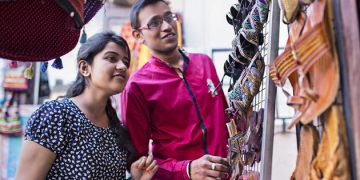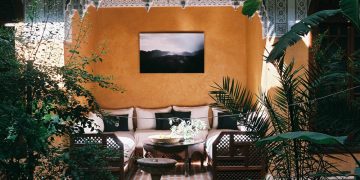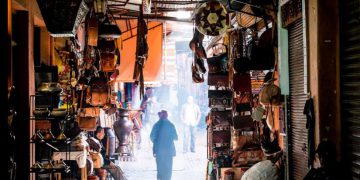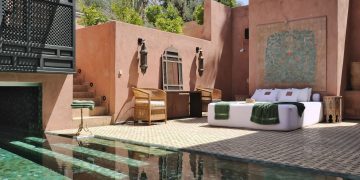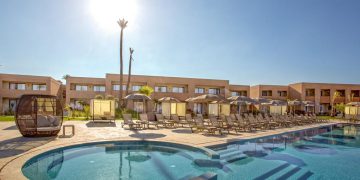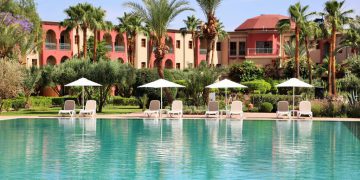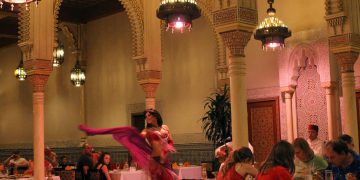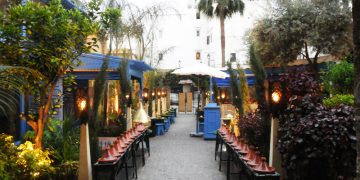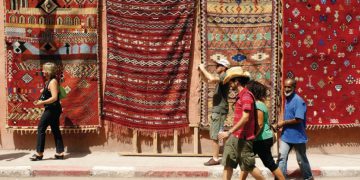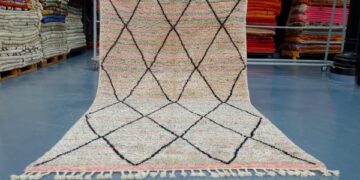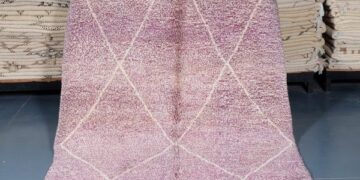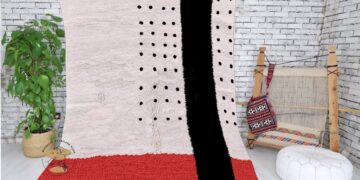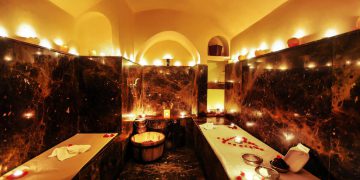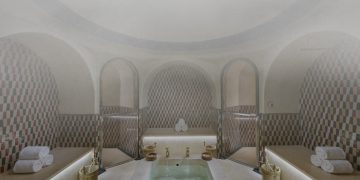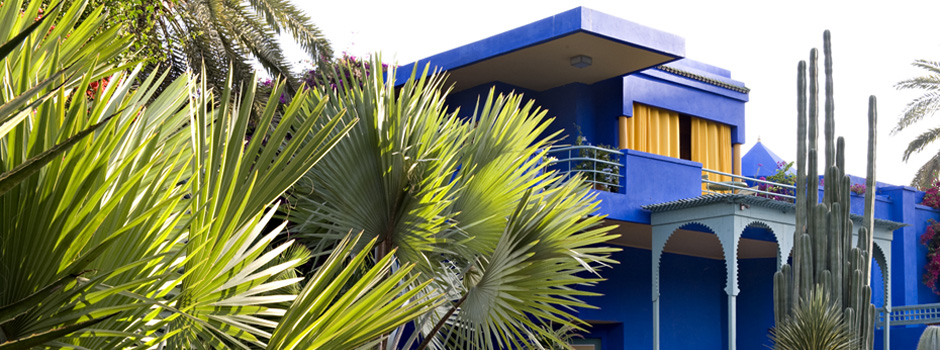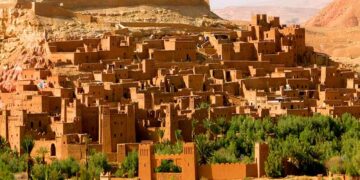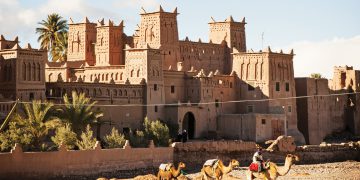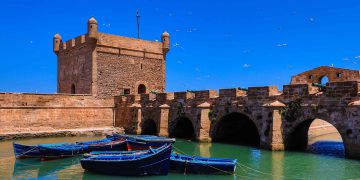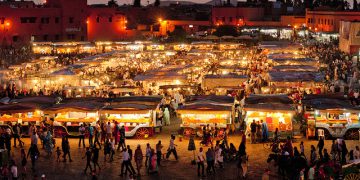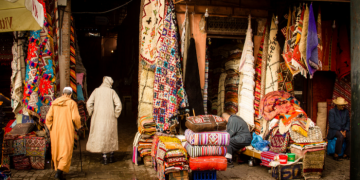
That’s what Jalil Lespert, the director of a brand new movie in regards to the lifetime of Yves Saint Laurent, the French designer, stated he felt throughout his time taking pictures in Morocco, on the finish of an exhausting schedule that had seen solid and crew retrace the steps of one of the crucial famend individuals in 20th century style.
I can’t fairly work out whether or not he’s being critical, or whether or not that is dry French humour, as he shortly provides: “At Majorelle and in Morocco it was nonetheless a good-humoured time – ultimately it was very nice filming there.”
The Majorelle Gardens are to be discovered on Rue Yves Saint Laurent, a way outdoors the medina partitions in Marrakesh, Morocco. Unassuming from with out, contained in the backyard is a cacophony of pink bougainvillea, blush-coloured water lilies, and cacti. The internal partitions are painted a vibrant cobalt shade, Majorelle blue, a shade named after the painter and founding father of the backyard, Jacques Majorelle.
It was a key filming location for Jalil Lespert, the director of a brand new movie in regards to the lifetime of Yves Saint Laurent, who died in 2008, and who acquired the backyard in 1980 to forestall it being changed into a lodge. That the road on which it’s situated now bears Saint Laurent’s title is one signal of the designer’s affinity with this north African nation.
Mr Lespert, who, like Yves Saint Laurent, has Algerian roots, explains that the style designer and his accomplice, Pierre Bergé, “couldn’t bear the concept of this public backyard turning into a lodge, in order that they did all they may to put it aside. They moved into the villa, made it and a part of the backyard non-public.”
The movie director had unprecedented entry to components of the backyard which can be off-limits to the general public, however factors out that it was Yves Saint Laurent who made them a public attraction – in the present day one of the crucial visited locations in Morocco: “I used to be actually fortunate to see these locations that belonged to Yves Saint Laurent and Pierre Bergé – it’s then that you just realise what, for them, was the pursuit of magnificence. Magnificence is not only what’s fairly – it’s the preservation of one thing and to have the frequent sense that the backyard would exist for Moroccans.”
He provides that the couple arrange a museum celebrating Berber tradition throughout the gardens – one thing which clearly struck a chord.
“My origins are Algerian and Berber, and in Morocco Berbers are a considerably separate group, one that isn’t at all times very effectively represented. They [Yves Saint Laurent and Pierre Bergé] had the initiative to create the Berber museum – the one Berber museum on the planet – contained in the Majorelle Gardens. It’s a small, great museum, the design is marvellous, very elegant, and it’s someplace that works – it self-finances, with individuals who work and complete households who reside by means of working within the backyard.”
Mr Lespert admires his topics: “They may have purchased non-public jets however they did that as a substitute, and that’s actually an indication of their honourable nature.”
He describes what it was like throughout filming to retrace the steps of the style designer’s life: “At one level within the movie you see [the actors] round a pond, and simply behind Pierre Niney [who plays Yves Saint Laurent], you must think about a small rose backyard which is the place the ashes of Yves Saint Laurent had been scattered by Pierre Bergé. We handed very close to right here and so there was one thing very particular there – it wasn’t morbid but it surely was one thing transferring.”
What was it about Marrakesh specifically that attracted Yves Saint Laurent? “The Marrakesh that Yves Saint Laurent found with Pierre Bergé in 1968 – or just a little bit earlier than – was not the Marrakesh of in the present day”, Mr Lespert says.
“It’s already fairly a wise vacation spot however then it was much less mainstream, nonetheless secret.”
It’s evident that the director has an intensive data of his protagonist and his travels in North Africa: “He found [the luxury Marrakesh hotel] La Mamounia, they stayed there one or two weeks. The climate wasn’t good the primary time they went there – that was the fact. It rained they usually stayed inside. I imagine it was sunny on their final day they usually went out.”
“Clearly Yves Saint Laurent was Mediterranean – he was born in Algeria – however Morocco has one thing that’s fully distinctive all through the Maghreb.”
It was the vibrancy of the colors, the sophistication of the design, and the refinement of the structure that appealed to the designer.
“There’s something free, beneficiant and sensual in individuals’s morals [in Morocco], and I believe it was that sensuality, that freedom, and that sophistication – as a result of Morocco is an especially refined nation too – with its delicacies, artisans, tradition, refined structure – I believe all of that actually appealed to him, and impressed him.”
“I believe the colors, too – there was above all one thing hanging in them – Majorelle blue – it was an oasis of inspiration for him.”
It’s no new factor that style designers are beneath immense inventive and business stress: Jalil Lespert’s movie reveals that Yves Saint Laurent, who grew to become head of one of many world’s nice style homes aged 21, wanted an escape from the extraordinary stress of Parisian life.
“Yves Saint Laurent was somebody who lived beneath nice ranges of stress – not solely did he have the couture collections annually, however the ready-to-wear, which he did all himself.

“That’s what I attempted to indicate in my movie – every present for him was a bit like presenting a play – it needed to please – every time there was loads driving on his work and there was loads to be misplaced. So I believe [Marrakesh] was someplace the place he may chill out an amazing deal.”
And though the Marrakesh that Yves Saint Laurent knew within the 1960s and 70s was not the identical because the Marrakesh of in the present day, Mr Lespert factors out that the designer continued to go to till the top of his life. I ask what he would suppose if he may see the Purple Metropolis as it’s in the present day. Certainly, his ashes are scattered within the Villa Oasis, his non-public residence in Marrakesh, and a memorial tower now stands within the Majorelle Gardens.
“He noticed it not that way back – he continued to go there”, comes the reply. “Marrakesh, all I can say is that his ashes relaxation there, which is critical, and Pierre Bergé sees himself going to Marrakesh, and to him. So I believe that it has a spirit that belongs to them.”


